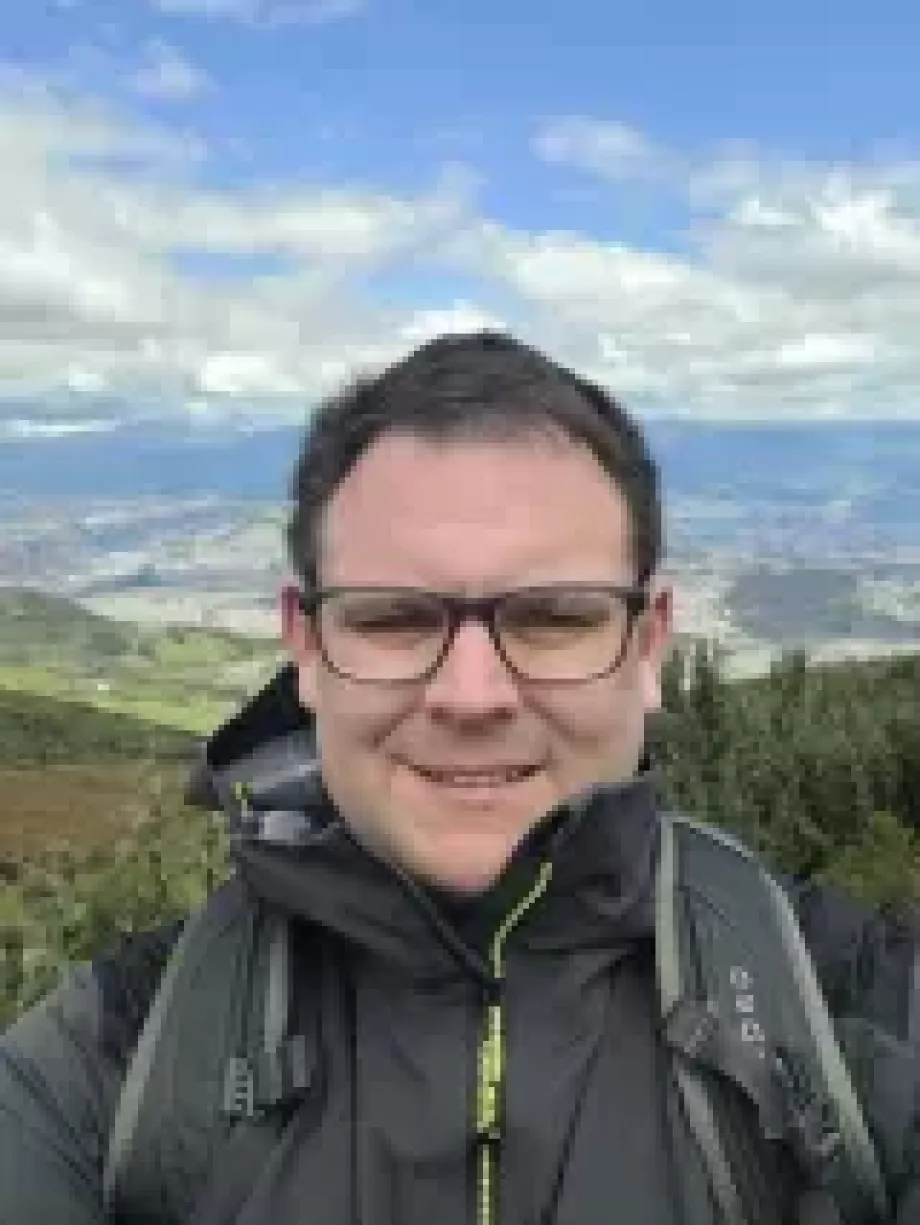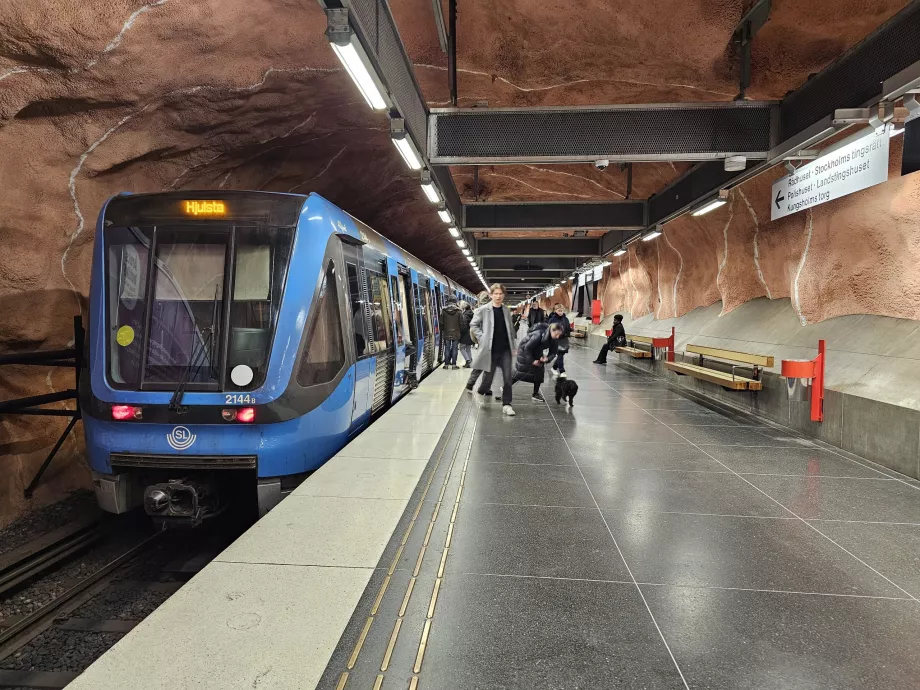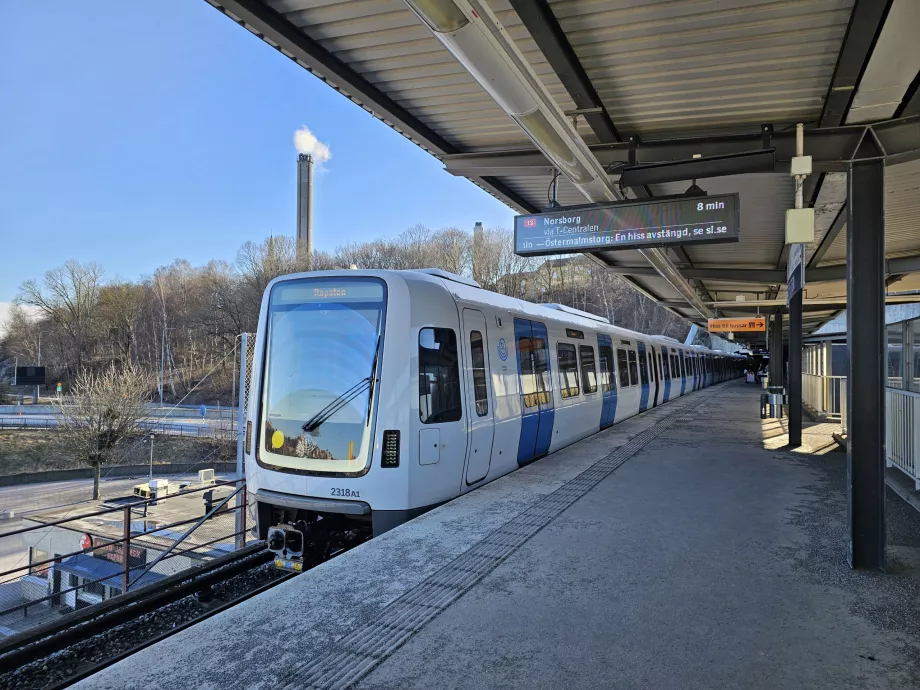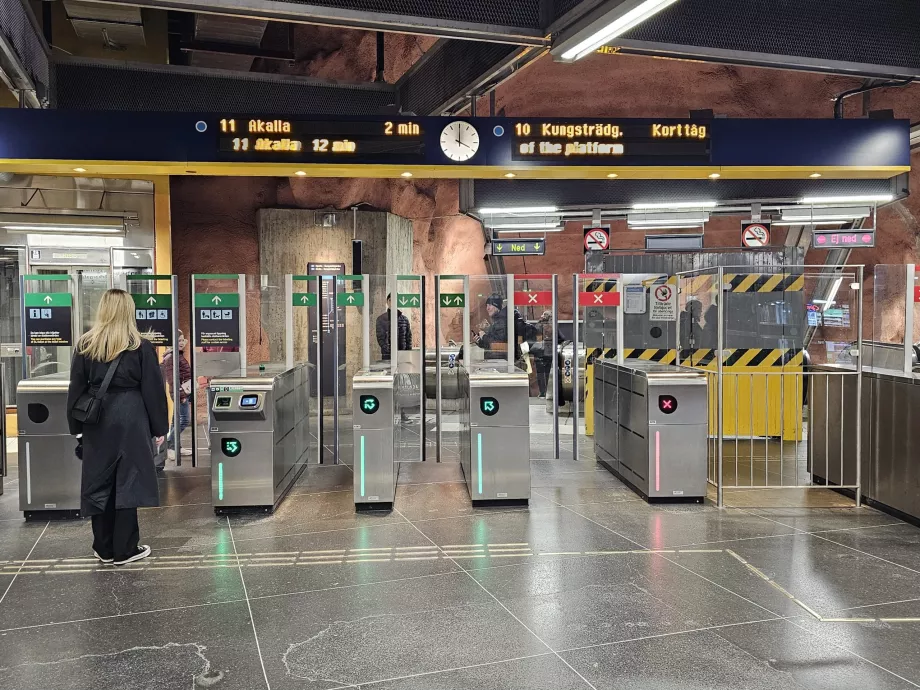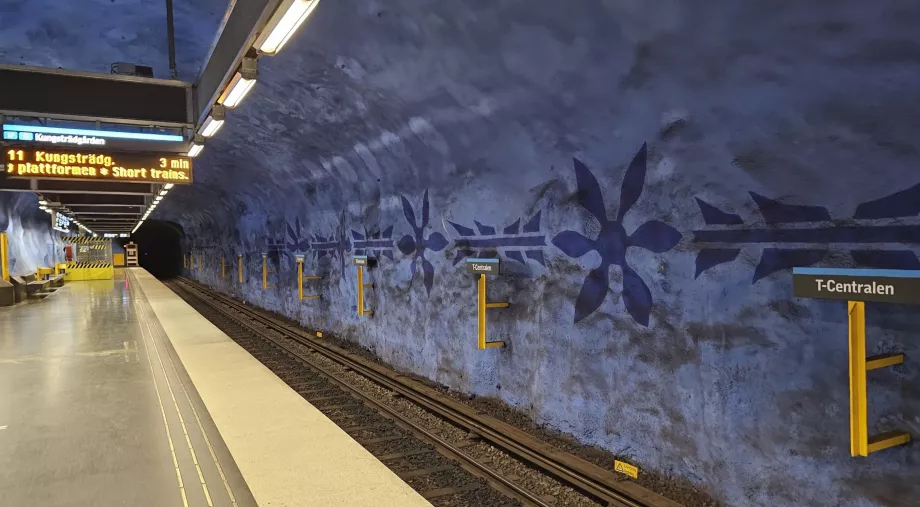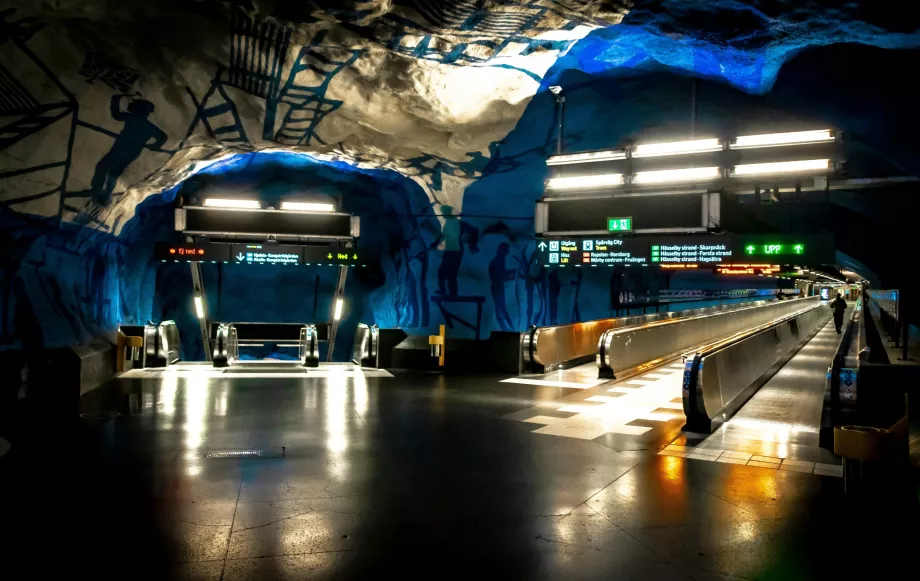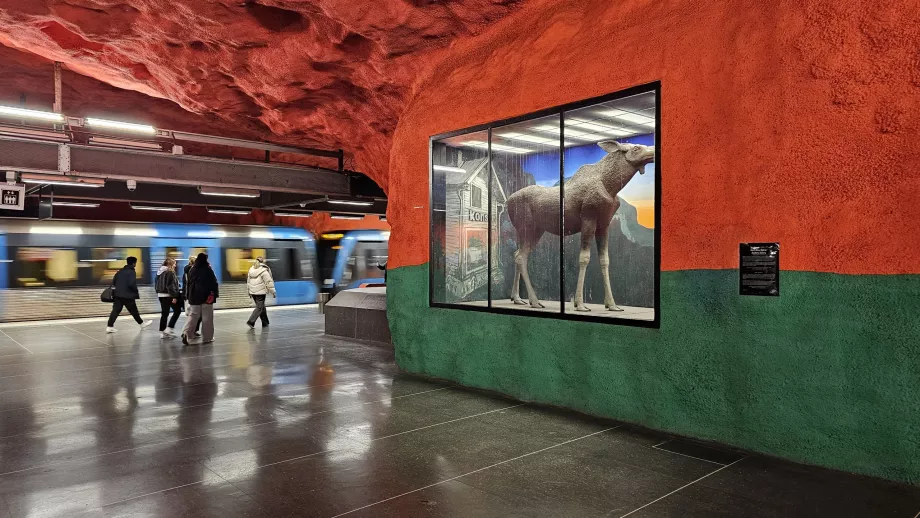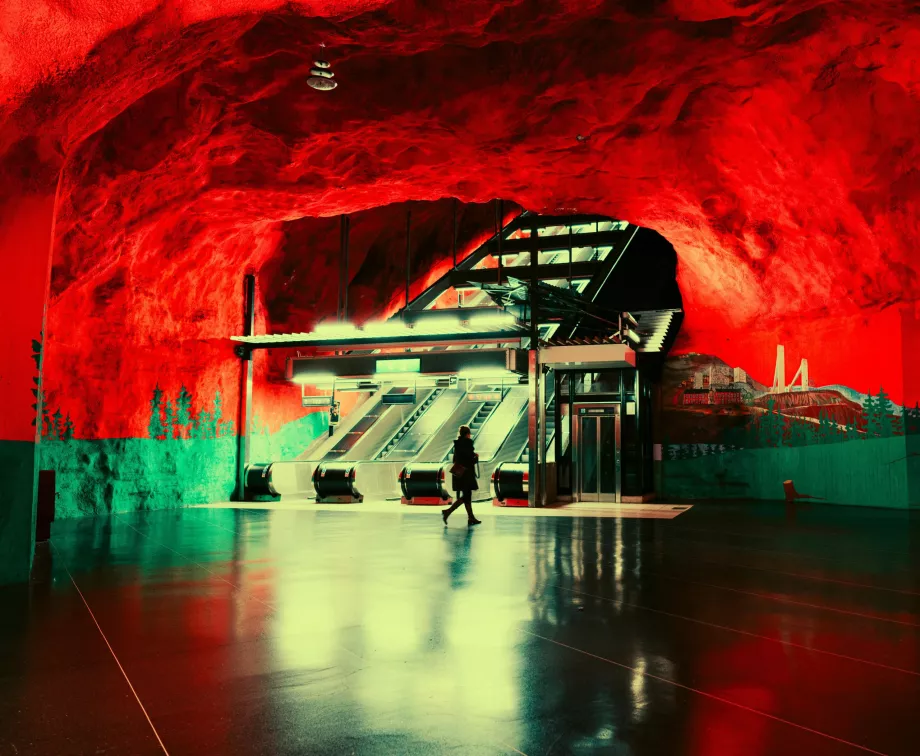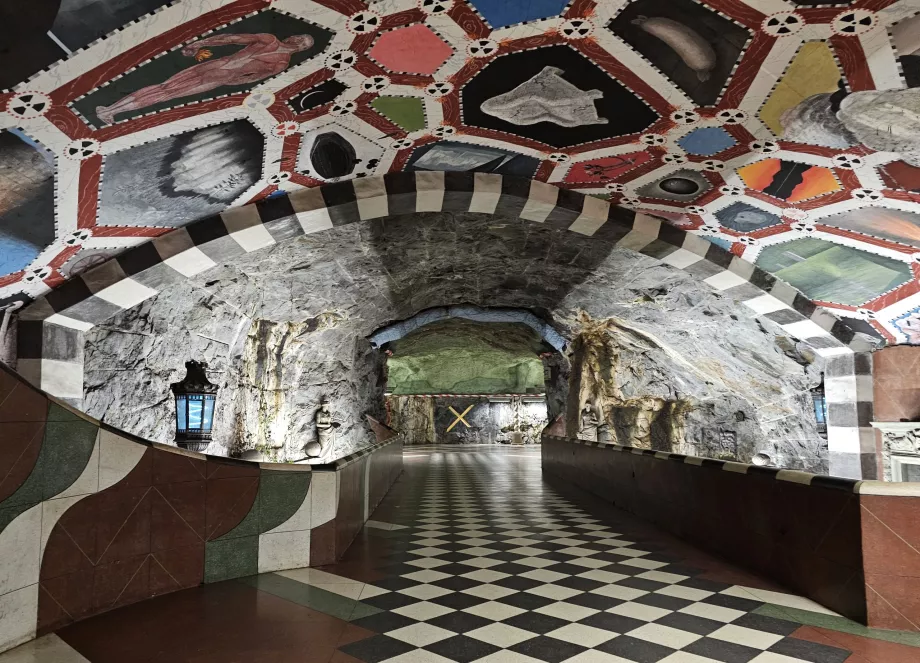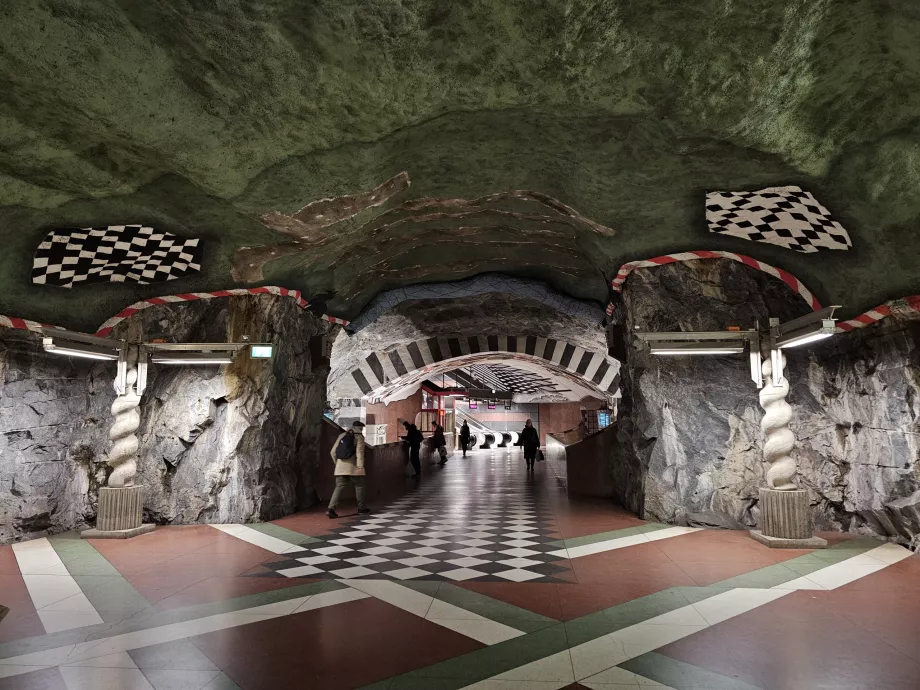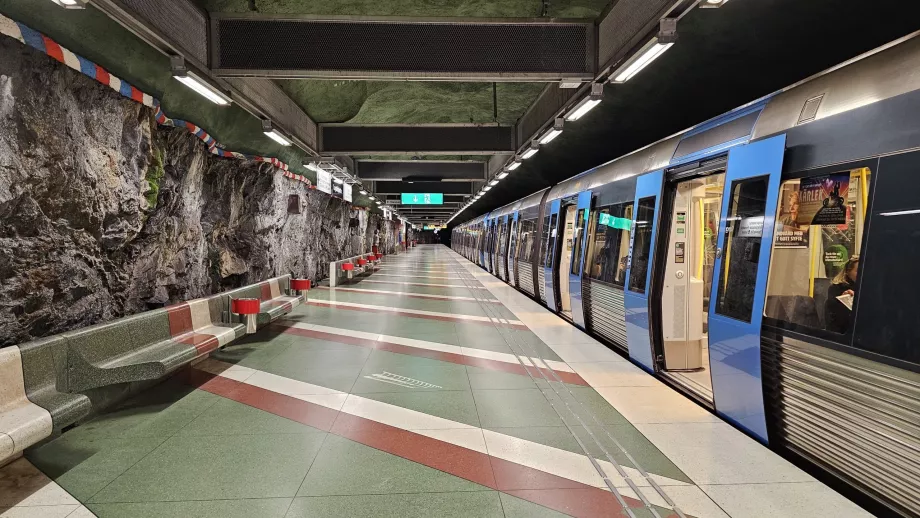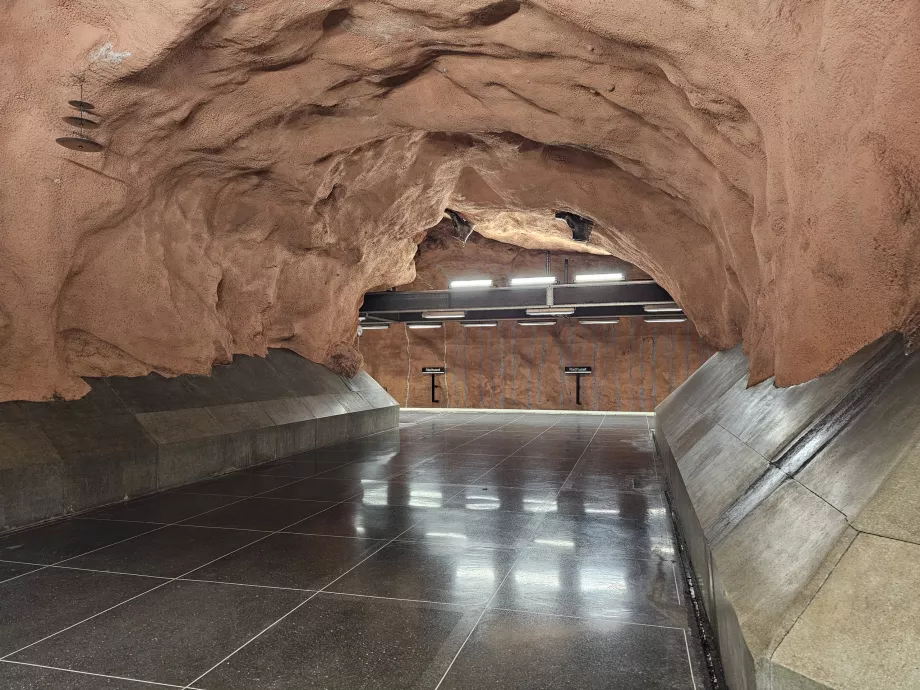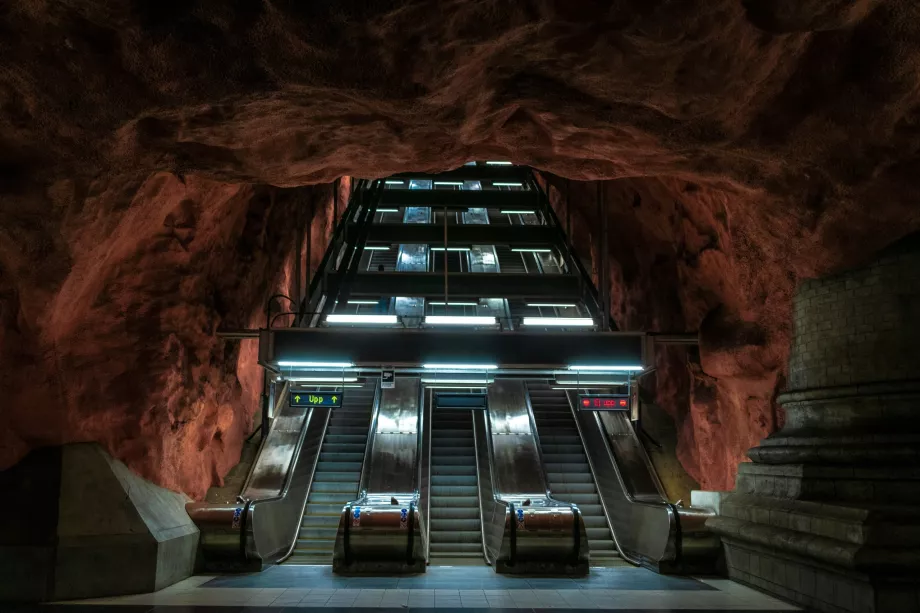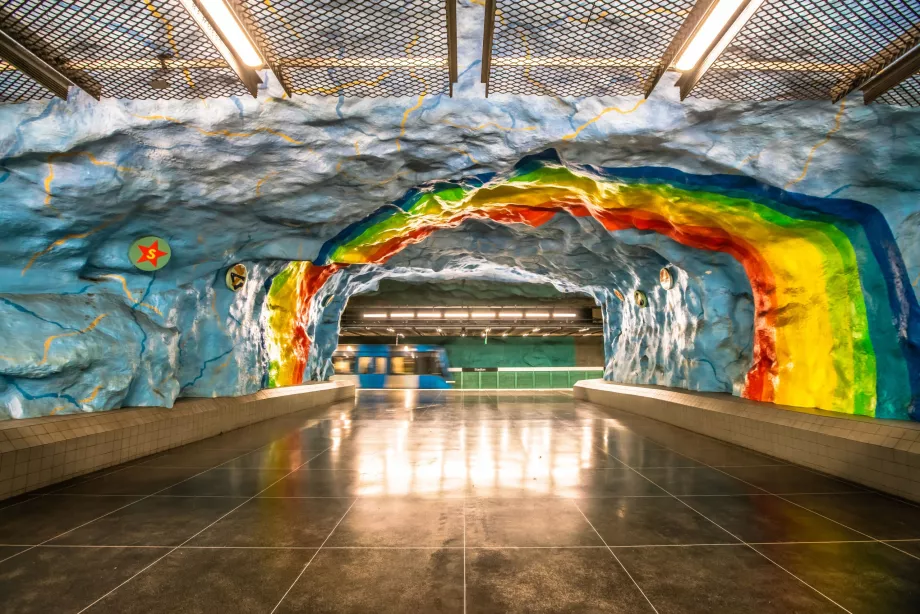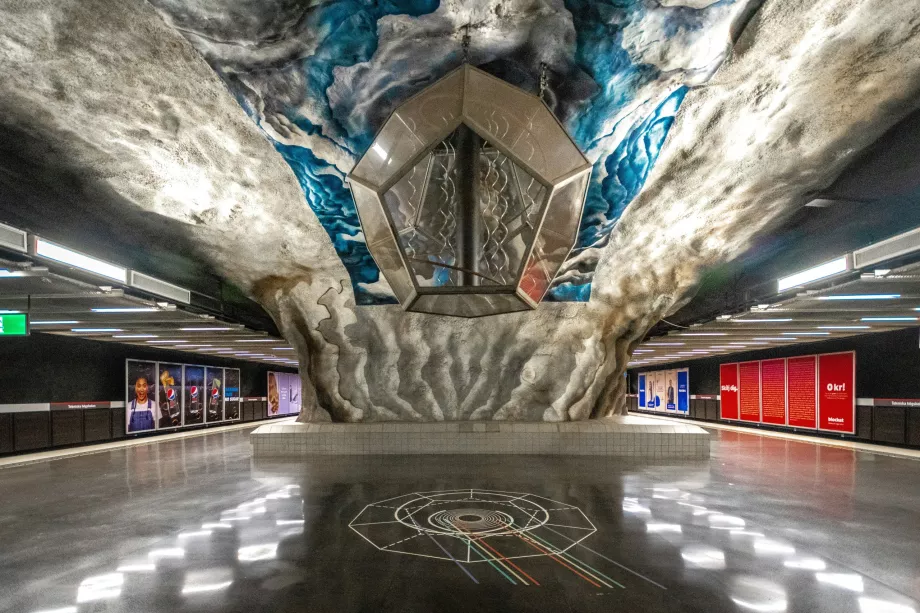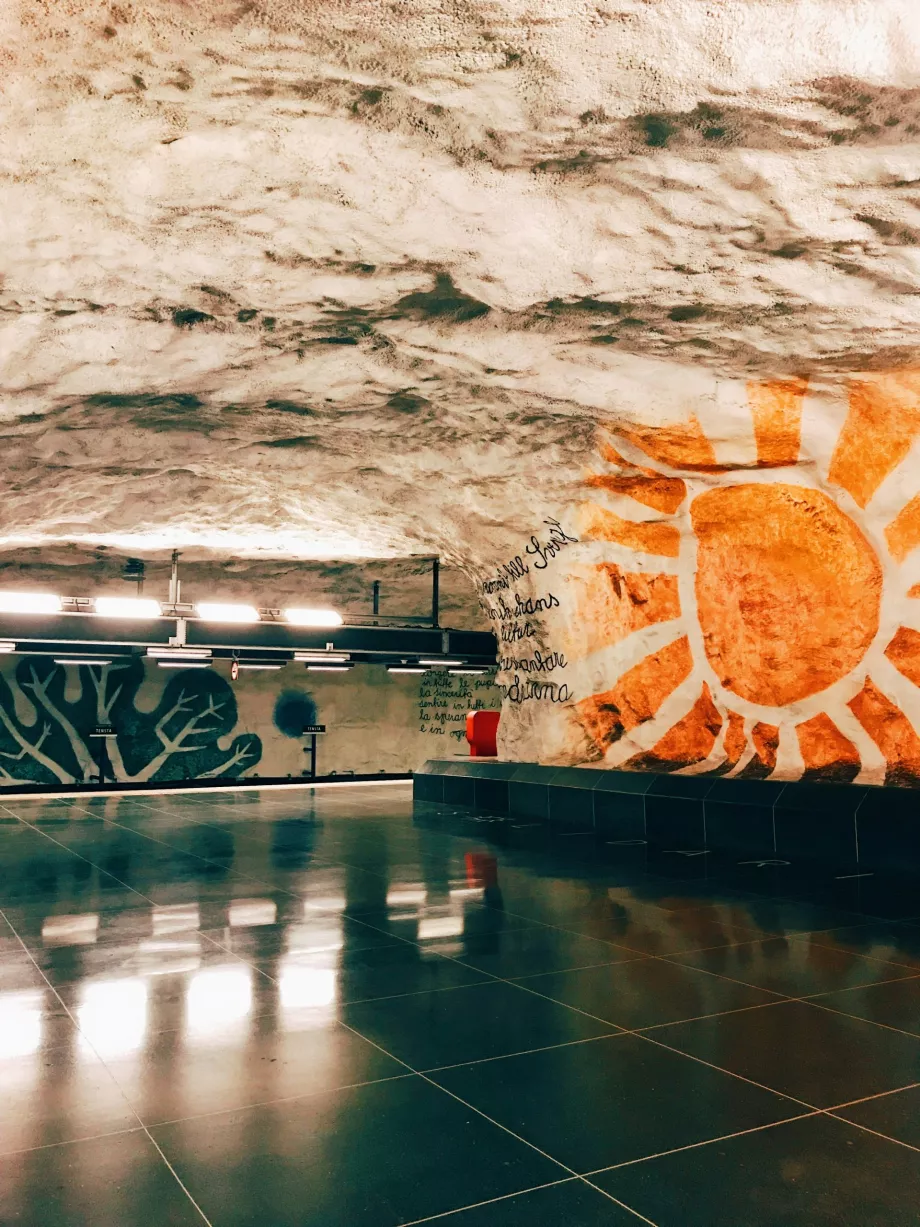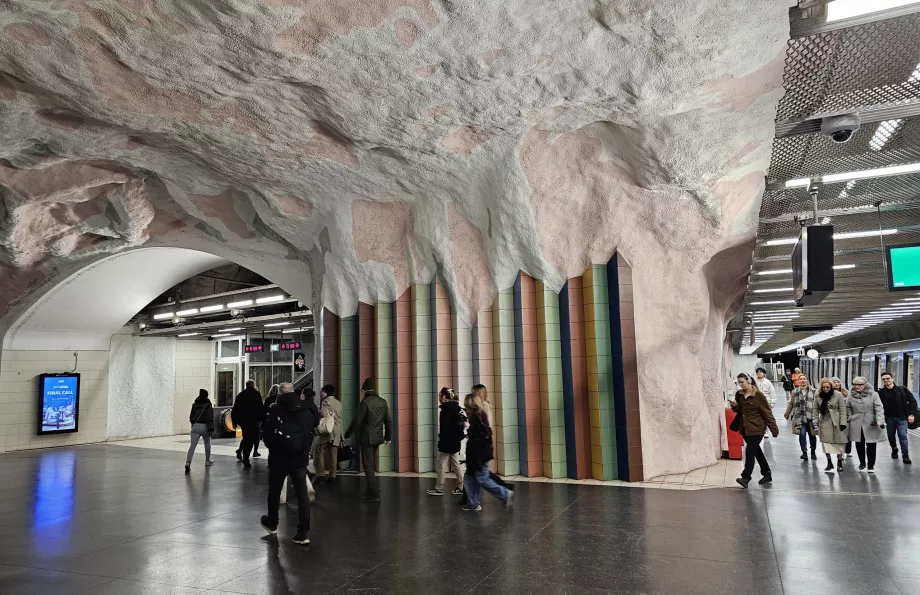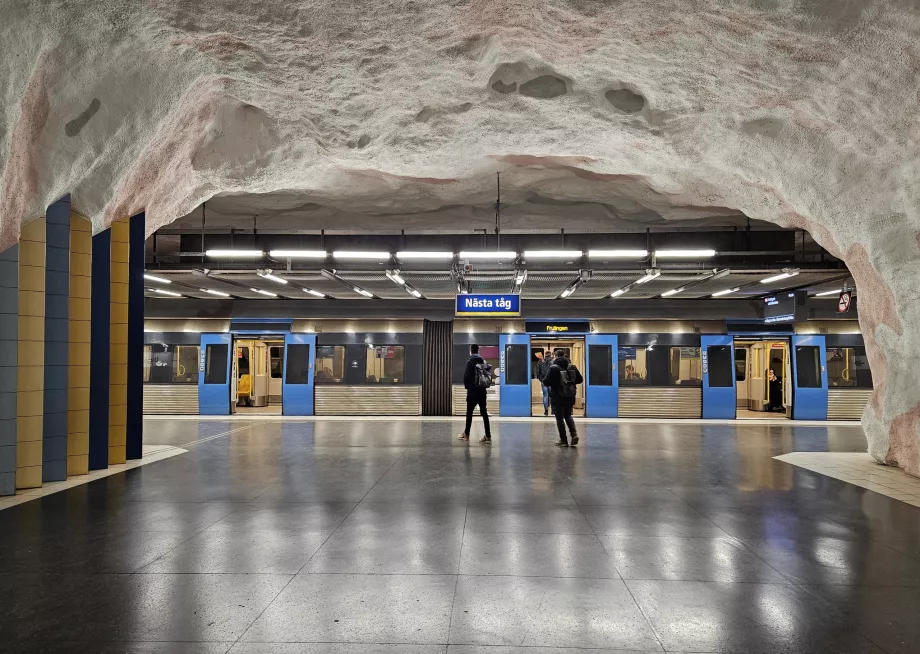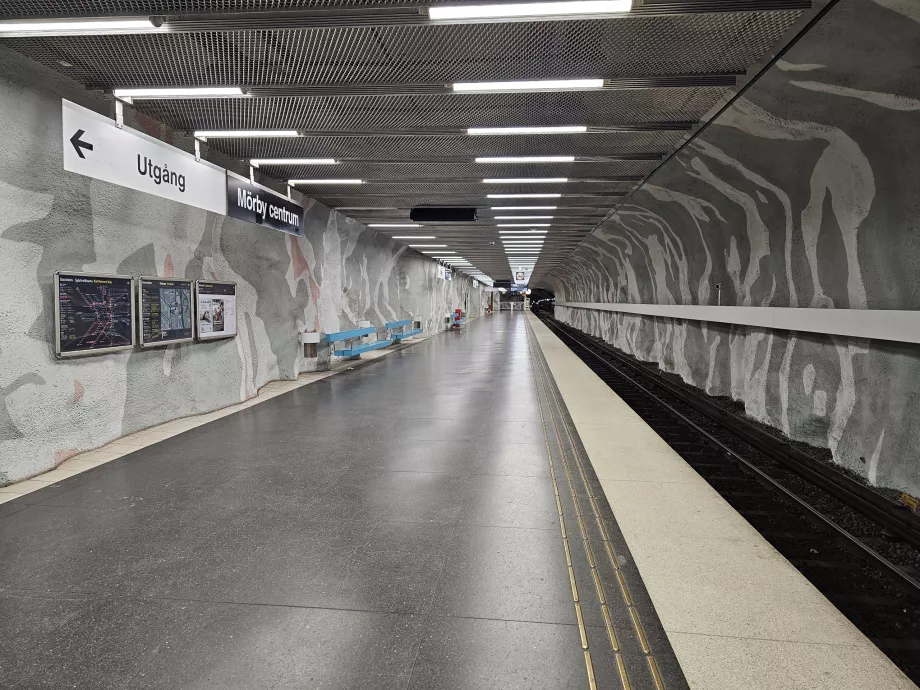Metro in Stockholm
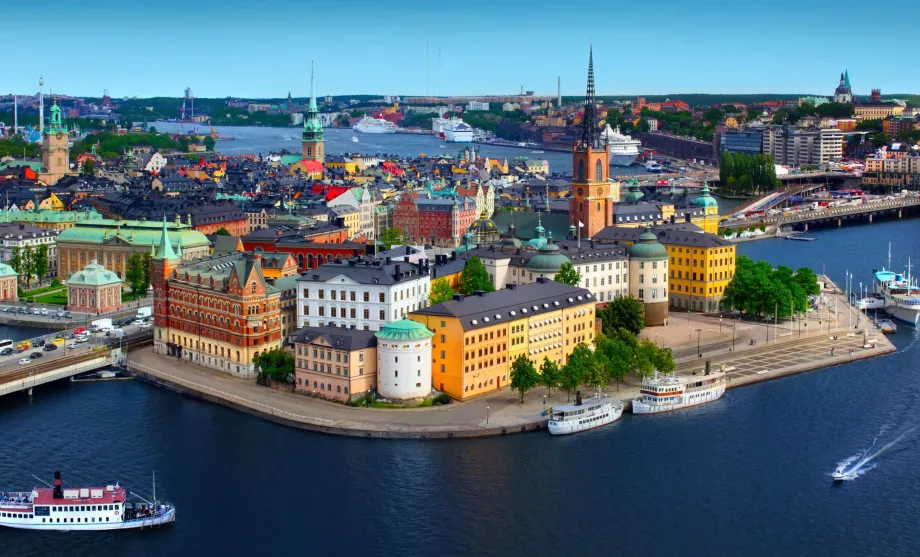
Stockholm's metro provides efficient, fast and clear transport throughout the city centre and to the outskirts.
On longer routes outside the centre, the metro is supplemented by Pendeltåg and local trains, which are described in more detail in the Transport chapter.
Choose a hotel in central Stockholm
Stockholm's metro is operated by the transport company SL, which is also responsible for all trains, trams buses and some ferries (lines 80-89). Official information, timetables and connection searches can be found on the sl.se website.
Metro map and lines
Stockholm's metro network has a total of 105 km of lines and 3 lines that branch off at the edges to form a total of 7 differently numbered routes.
The official subway map can be found at: sl.se/reseplaneringspartrafikkartor.
The metro lines are divided by colour and route number.
All metro lines cross at the T-Centralen station, which is located right in the centre by the main train and bus station.
- Blue - the line runs from the centre (Kungsträdgården and T-Centralen) towards the northeast, where it splits into two branches at Västra skogen station.
- Line 10 - runs from the centre through the Sundbyberg district to the Hjulsta terminus.
- Line 11 - runs from the centre via Solna to Akalla.
- Each line has an interval of 10 minutes and in the central part, when both lines run together, the frequency is therefore 5 minutes.
- Red - the route runs north-south through the centre and splits into two branches at either end. The two lines run together through the centre on the Östermalmstorg - Liljeholmen section.
- Line 13 - runs from Ropsten station via Gärdet (long-distance ferry terminal), the centre and Södermalm south-west to Norsborg station.
- Line 14 - runs from Mörby Centrum station via the centre and Södermalm to Fruängen station.
- Each line has an interval of 10 minutes and in the central part, when both lines run together, the frequency is therefore 5 minutes.
- Green - the route connects the western and southern suburbs of Stockholm. It splits into three different branches at Gullmarsplan station in the south of the city.
- Line 17 - runs from Skarpnäck station through the centre to the Hässelby terminus. Some trains end at Gamla Stan station, where you can change to lines 18 and 19, which continue along the same route.
- Line 18 - runs from Farsta station through the centre to Hässelby terminus. Some trains end at Gamla Stan station, where you can change to lines 17 and 19, which follow the same route.
- Line 19 - always runs the whole route from Hagsätra station to Hässelby terminus
- In the common section the resulting interval is 5 minutes and on each of the three branches in the south of the city the frequency varies between 10 and 15 minutes.
As Stockholm's metro is significantly complemented by trains and trams, we attach below a complete map of rail transport in Stockholm.
Metro tickets
The same fares apply on the metro as on trams, buses, trains and ferries.
You can make any number of transfers between all means of transport on one ticket.
| Ticket type | Validity | Price (adults) | Price (over 65 and under 20) |
|---|---|---|---|
| Single journey | 75 minutes | 42 sek | 26 sek |
| One day | 24 hours | 175 sek | 110 sek |
| 3-day | 72 hours | 350 sek | 220 sek |
| 7-day | From 0:00 on the first day to 4:30 on the second day after the 7-day period |
455 sek | 290 sek |
For current prices, please visit the official website: sl.se/fares--tickets.
How to buy a ticket?
You can buy tickets in three ways.
The SL mobile app
The cheapest and easiest way is to install the SL mobile app. No complicated registration is required.
Once you've purchased your ticket, you'll need to activate it with one click and keep your phone handy while travelling. The ticket is displayed in the form of a QR code that you have to scan at the turnstile when you enter the metro.
The QR code is only ever scanned when you board.
Smart Card
You can also use a physical ticket in the form of a card. You can reload different tickets on this card. However, only one ticket can be on the card at a time.
Like your phone when using the mobile app, you must always place the card at the turnstile when you enter the metro.
The disadvantage of the card is the additional fee 20 sek for issuing it.
The SL Smart Card can only be purchased at the ticket counters in each metro station or at Pressbyrån newsagents. Ticket machines are not available anywhere.
Paying with your own contactless card
In Stockholm, you can also pay fares with your own card in the same way as the SL Smart Card. You always attach the card to the turnstile when you enter the station.
However, you can only pay with your own card for a single fare of 75 minutes at 42 sek.
In Stockholm, unfortunately, all-day limits do not work with this form of payment as they do in many other cities. If you travel a lot, you can pay considerably more per day than 175 sek, which is the price for a day ticket purchased on the mobile app or Smart Card.
Timetables - does the metro run 24/7?
The metro runs the same frequency every day with each line running 10-15 minutes depending on the time of day.
However, in the central area, more lines always run together, reducing the final interval to 5 minutes.
The metro runs continuously throughout the night only from Friday to Saturday and from Saturday to Sunday.
On the other days, the first trains leave the termini between about 4:50 and 5:00 and the last trains usually leave around 0:30 to 0:45, so that around 1:00 to 1:15 the last trains leave the centre towards the outskirts of the city.
Detailed timetables can be viewed at this link: sl.linjetidtabeller.se.
How are the stations equipped?
In some metro stations you will find vending machines with drinks and sweets, and in the vast majority of cases also Pressbyrån newsagents, 7-Eleven mini-markets or small cafés and bakeries.
These shops are always located in the lobbies before you even enter the platform.
Public toilets at stations are not standard (except at the main transfer station T-Centralen).
Entrances to metro stations are marked with a blue letter T, which comes from the Swedish name for the metro - Tunnelbana.
The art of the Stockholm Metro
The Stockholm metro is unique in the design of some of its stations, which attract the attention of tourists from all over the world.
Different stations are decorated with different motifs referring to Swedish or Stockholm's history and culture.
The colourful stations with their unique architecture are in themselves partly a work of art and partly a reminder of the harsh natural conditions in which the metro was built: the stations often have only roughly machined walls, giving passengers a view of the rocky cliffs.
Compare prices for flights to Stockholm
The 8 best metro stations in Stockholm
Where to go for the most beautiful and interesting stations? Check out the unique map, photos and descriptions of each station.
T-Centralen (blue line)
The most accessible interesting station is T-Centralen. While the T-Centralen station areas on the Red and Green lines are conventional utilitarian, the station on the Blue Line is a work of art.
The station is coloured in soothing tones of light blue and white and the motifs depict climbing plants. In the upper vestibule, the walls depict silhouettes of workers working on the metro construction.
The floor of the station is designed to give the appearance of 3D cubes in brown, white, black and green when viewed in close-up.
The look of one of Stockholm's busiest stations was deliberately created in peaceful colours to contrast with the endless hustle and bustle of everyday life.
Solna Center
Arguably the most famous station, the bold red and green colour scheme depicts aspects of the Swedish countryside. Solna centrum is also located on the blue line.
The green colour represents the endless forests, while the red colour represents the setting sun over the horizon. Added are paintings depicting typical rural scenes such as picking cranberries or working in the fields.
However, the paintings also have a socio-political context and depict the pressing problems of rural Sweden in the 1970s when the station was created. You will notice depictions of drastic deforestation or depopulation of the countryside.
One of the station's iconic symbols is the sculpture of a moose in a glass case.
Kungsträdgården
The final station of the Blue Line right in the centre is one of the most unique with a rather wild design.
Parts of the walls are left in a completely unworked state, showing the original rock in which the Stockholm metro was dug.
Most of the station, however, is decorated with a wild combination of colours and copies of statues. The colouring and sculptures are reminiscent of the colours of the original baroque garden Kungsträdgården, which was located in the area above the present station.
During the construction of the metro, many archaeological elements were found, to which the sculptures refer.
Rådhuset
Rådhuset station is also on the blue line. At first glance, the station has a clean simple design and is wrapped in a very soft shade of pink.
But if you look closely at the station walls, you will find many details reminiscent of historical relics from the area directly above the station.
On the ceiling in the central part of the platforms, for example, you will find sculptures of two craftsmen's shoes or many baskets from Hantverkargatan, which was a centre for craftsmen in the past and lies directly above the station.
At the exit to the escalators, the ceiling is supported by the base of a factory chimney, which were very present in this area in the 19th and 20th centuries.
Stadium
Every summer the Östramalms IP stadium, near which the "Stadion" station on the Red Line is located, is the venue for the Stockholm Pride festival.
The ceilings of this light blue station are therefore decorated with a rainbow, a typical emblem of the LGBT community.
Tekniska Högskolan
The station on the Red Line near the famous KTH University is a tribute to scientific discovery.
The most striking feature of the station is the five hanging polyhedrons representing Plato's five kinds of material bodies: fire, water, air, earth and ether
Tensta
Almost to the end of one of the branches of the Blue Line (route number 10), visit the Tensta station, which is decorated with paintings of dandelion leaves and animals combined with small animal statues.
The artists have deliberately depicted animal species from all over the world on the walls of the station, as immigrants from various countries moved to the Tensta housing estate during the construction of the metro in the late 1960s and early 1970s.
Mörby Centrum
The terminus of one of the northern branches of the Red Line (number 14) resembles a candy store rather than a metro stop with its colouring and rainbow ceramic decorations.
The colouring is unobtrusive and is dominated mainly by light tones of pink and white. If you look closely, however, the walls and ceilings change colour slightly depending on where you're looking at them from. From one side they appear grey with a hint of pink, while from the other side they appear white with grey-green elements.
This illusion is meant to symbolise the changing landscape when travelling by train (the southern part of the Red Line is overhead).
Map of interesting stations
To get a better idea of where Stockholm's most interesting stations are located, we have prepared a modified map of the Stockholm metro.
Any questions left?
If you have any questions or comments about the article...
